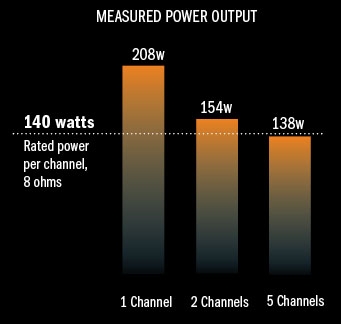Where the Elite Meets to Greet the Beat Page 3
TEST BENCH

DOLBY DIGITAL PERFORMANCE All data were obtained from various test DVDs using 16-bit dithered test signals, which set limits on measured distortion and noise performance. Reference input level is -20 dBFS, and reference output is 1 watt into 8 ohms. Volume setting for reference level was -9. All level trims at zero, except for subwoofer-related tests, all speakers were set to "large," subwoofer on. All are worst-case figures where applicable.
Output at clipping (1 kHz into 8/4 ohms) 1 channel driven: 208/312 W (23.2/24.9 dBW) 5 channels driven (8 ohms): 138 W (21.4 dBW) Distortion at 1 watt (THD+N, 1 kHz) 8/4 ohms: 0.05/0.05%* Noise level (A-wtd): -75.2 dB* Excess noise (with sine tone) 16-bit (EN16): 0.5 dB* Frequency response: 20 Hz to 20 kHz +0, -0.3 dB
MULTICHANNEL PERFORMANCE, ANALOG INPUT Reference input and output level is 200 mV; volume setting for reference output level was -4. Distortion (THD+N, 1 kHz, 8 ohms): 0.08%* Noise level (A-wtd.): -87.6* Frequency response: <10 Hz to 160 kHz +0, -3 dB
STEREO PERFORMANCE, DIGITAL INPUT Reference level is -20 dBFS; all level trims at zero. Volume setting for reference level was -5.
Output at clipping (1 kHz, 8/4 ohms, both channels driven): 154/262 W (21.9/24.2 dBW) Distortion at reference level: 0.03%* Linearity error (at -90 dBFS): 0.15 dB Noise level (A-wtd): -75.6 dB* with 96-kHz/24-bit signals: -85.4 dB* Excess noise (with/without sine tone) 16-bit (EN16): 0.3/0.7 dB* quasi-20-bit (EN20): 7.3/5.7 dB* Noise modulation: 0.6 dB Frequency response: <10 Hz to 20 kHz +0, -0.3 dB with 96-kHz/24-bit signals: <10 Hz to 44.5 kHz +0.1, -0.6 dB
*Noise and distortion tests required insertion of a "brickwall" low-pass filter to suppress very high-frequency ultrasonics that were present on all speaker outputs. (Almost certainly artifacts of Class D switching frequency, these were not seen on line-level output traces.). This may have affected results to a very slight degree.
BASS-MANAGEMENT PERFORMANCE Measured results obtained with Dolby Digital test signals. Subwoofer-output frequency response (crossover set to 80 Hz): 24 dB/octave (approx.) above -6-dB rolloff point of 80 Hz High-pass-filter frequency response (crossover set to 80 Hz): 12 dB/octave below -3-dB rolloff point of 80 Hz Maximum unclipped subwoofer output (trim at 0): 7.3v Subwoofer distortion (from 6-channel, 30 Hz, 0 dBFS signal; subwoofer trim set to 0): 0.03%* Crossover consistency: bass crossover frequency and slope were consistent for all sources and formats Signal-format consistency: consistent for all applicable formats Speaker size selection: all channels can be set to "small" Speaker-distance compensation: available for all main channels.
The SC-07's power output was impressive on just about every test-especially from a receiver that weighs only 50 lb, and never got more than modestly hot. As more channels were driven, maximum power fell off comparatively linearly-much more so than is usually the case with conventional, regulated Class A/B designs. (Class D uses available power supply current much more efficiently, but it's not nuclear fission: the supply is still finite). Other test were generally excellent throughout. What I took to be artifacts from the amplifiers' switching frequencies (at a guess, several hundred kilohertz), were visible on scope traces of all speaker outputs. While these made taking certain measurements a bit challenging, they are sonically not significant, being many times higher than the highest frequency of interest.
- D.K.













































